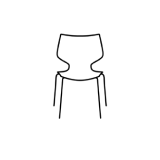
Blog
Your go-to destination for design inspiration and practical tips to transform your home. Discover the latest interior trends, style hacks, and budget-friendly ideas to create a space you'll love.
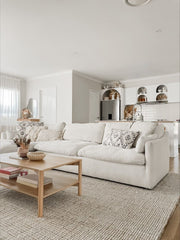
Coffee Tables 101: A Comprehensive Guide to the Living Room Centrepiece
Image credit: soul.and.habits The Living Room is often the heart of a home—a space where families gather, friends connect, and conversations flow. And at the centre of this social hub sits the unsung hero, the coffee table. More than just a surface for holding mugs and magazines, the coffee table is a key element in defining your living room's style and functionality. In this guide, we will delve into the various aspects of coffee tables, helping you make the right decision, when choosing the perfect centrepiece for your living space. What is the main purpose of a coffee table? Before we get into the vast array of coffee table options, let's understand the fundamental role this piece plays in your living room. Coffee tables are not just a surface; it's a multifunctional furniture item that serves as a: Gathering Point: It brings people together, creating a central space for activities, games, and conversations. Style Statement: A well-chosen coffee table can define the aesthetic of your living room, whether it's classic, modern, eclectic, or minimalist. Functional Hub: From holding your morning coffee to providing a surface for books, remotes, and décor, it's a practical addition to your space. What Style and Material should you choose? Coffee tables come in a variety of styles and materials, each contributing to a distinct look and feel. Here are some popular styles: Classic Coastal: Timeless charm with ornate detailing, often using light or painted timber finishes to bring the essence of the ocean into your home. Embrace timeless coastal charm in your living space with our Hamptons Coffee Table, where the quintessential Hamptons design meets a crisp painted white finish, creating the ideal beachside centrepiece for your home. Modern Coastal: Clean lines and a contemporary twist with materials such as rattan combined with warmer timber textures. The Georgia Coffee Table will elevate your living room with a fusion of modern coastal elegance. Featuring brushed brass hardware, rattan accents, and a sleek white finish, this table effortlessly captures the essence of contemporary coastline style. Mid-Century Modern: A combination of sleek or curved lines, minimal ornamentation, and rich darker timbers define this vintage-inspired style. Discover the epitome of Mid-Century Modern sophistication with styles like our Arc Coffee Table. The warmth of timber texture and a distinctive curved base seamlessly blend to create a statement piece that embodies the essence of timeless mid-century design, adding a touch of retro charm to your living space. Urban Industrial: Raw and utilitarian, often featuring metal and raw timber look for a functional aesthetic. For an urban industrial vibe in your living area, we suggest styles like our Vigo Nesting Coffee Table. Crafted with the durability and sturdiness of metal legs and enriched by rustic timber textures, these tables epitomize the perfect blend of contemporary style and industrial strength, making them an ideal addition to your modern urban space. Scandinavian: Known for clean, simple lines and a focus on light-coloured woods, contributing to a minimalist yet inviting look. Experience the essence of Scandinavian design with the Blair Coffee Table. Imbued with timeless light timber texture, sleek tubular legs, and practical storage space, this table effortlessly embodies the simplicity and functionality that define Scandinavian style, making it a chic and functional addition to your living space. When choosing a style, consider how it complements the overall theme of your living room. What Size and Proportion should you choose? Selecting the right size for your coffee table is crucial. It should be proportionate to your seating area, ensuring a harmonious balance. Here are some guidelines: Height: Ideally, it should be at or just below the seating height, making it easy to reach items. Length: Choosing a coffee table that is two-thirds the length of your sofa, helps maintain a balanced look. Shape: Square or rectangular tables often work well in traditional settings, while round tables can soften the lines in a modern room. Functionality: More Than Meets the Eye Modern coffee tables go beyond being a static surface. Many come with built-in storage, transforming them into practical pieces that help declutter your living room. Consider options with drawers, shelves, or hidden compartments, especially in smaller spaces. Cohesiveness Matching your coffee table to your existing style and addressing specific needs, creates a cohesive and harmonious look in your living space. If your home lacks warmth, consider introducing a timber coffee table to add that natural, inviting feel. Need more storage? Opt for a coffee table with ample storage space to keep your living area organized. Working with a smaller space? A round coffee table might be the perfect fit, offering functionality without overwhelming the room. How to Personalise your Coffee Table Once you've chosen the perfect coffee table, it's time to bring it to life with carefully curated décor items. Consider adding the following: Books: A selection of coffee table books adds visual interest and can be great conversation starters. Trays: Use decorative trays to corral smaller items and create a tidy appearance. Plants: Add a touch of nature with a potted plant or a vase of fresh flowers. Personal Items: Showcase items that reflect your personality, whether it's family photos or unique collectibles. When choosing the right coffee table, consider more than just finding a surface to place your cup of coffee; selecting a piece that enhances your living space. From style and size to functionality and maintenance, each aspect plays a key role. Consider this guide your roadmap to finding the perfect coffee table—one that not only serves your practical needs but also contributes to the overall aesthetic of your home.
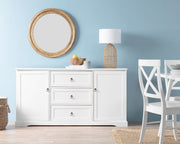
Creating the Perfect Hamptons Home: A Timeless Coastal Haven
Welcome to our guide on how to create the perfect Hamptons home, a timeless coastal haven that exudes elegance and relaxation. Originating from the breathtaking Long Island, Hamptons style design effortlessly blends traditional elements with coastal influences to create a breezy, elegant aesthetic. In this blog, we will explore the key characteristics of Hamptons style, delve into its essential elements, offer tips for designing an interior with a coastal palette, and highlight how this iconic style can be adapted to Australian homes. Let's embark on a journey to create a home that epitomizes the timeless allure of the Hamptons. What is Hamptons Style Design? Hamptons style design finds its roots in the picturesque Long Island, known for its stunning coastal beauty and luxurious vacation homes. This style intertwines traditional and coastal elements, resulting in a harmonious blend that captures the essence of relaxed sophistication. With an emphasis on natural textures, such as timber and rattan, the Hamptons aesthetic creates an atmosphere that feels light, airy, and effortlessly chic. Essential Elements of Hamptons Style: To create the perfect Hamptons styled home, it is important to incorporate key elements that define this timeless aesthetic. Natural textures, like timber and rattan, add warmth and character to the space, while a light colour palette of whites, creams, and soft blues enhances the breezy coastal vibe. By combining these elements, you can transform your home into a Hamptons style haven, exuding a sense of refined elegance. Designing the Interior with a Coastal Palette: Designing your Hamptons-style home calls for a coastal-inspired colour scheme. Picture the serene ambiance of a beach house with soft blues, sandy beiges, and creamy whites evoking the calmness of the ocean and pristine sand. This harmonious palette brings lightness and sophistication, embodying timeless Hamptons elegance. Your home, adorned with these coastal-inspired colours, becomes a sanctuary of relaxation, transporting you to tranquil shores. Embrace the Hamptons palette, and let the colours guide you to a breezy and elegant retreat, capturing coastal living's essence with timeless flair. Integrating Design Elements in Every Room: For a cohesive Hamptons look throughout your home, it's essential to integrate design elements in every room. Choose furniture that complements this aesthetic, such as pieces made with timber and natural textures. Embrace clean lines, classic silhouettes, and elegant detailing to maintain the timeless appeal of Hamptons style. Upholstery in soft, natural fabrics, like linen, further enhances the aesthetic while providing a cosy and inviting atmosphere. Coastal Inspirations: Infusing the Modern Hamptons Style: To infuse a modern twist into the traditional Hamptons style, embrace elements of traditional Hamptons style with a contemporary touch. Incorporate modern accents, such as metallic finishes or geometric patterns, while still utilising traditional materials and timeless colour palettes. This fusion of classic and modern elements creates a design that is both sophisticated and fresh, bringing the Hamptons style into the present. Creating a Timeless and Elegant Hamptons Style House: One of the defining qualities of the Hamptons style is its timeless appeal. The lifestyle and ambiance that it embodies, known as -coastal living', transcends trends and fads, offering a sense of luxury and comfort that stands the test of time. With its refined aesthetics and soothing atmosphere, a Hamptons style house creates a sanctuary where you can relax and enjoy the timeless elegance that this design represents. Adopting the Australian Lifestyle in Hamptons Interior Design: Adapting the Hamptons style to Australian homes involves embracing outdoor living that epitomizes the Australian lifestyle. Incorporate timber furnishings and accessories that combine indoor and outdoor spaces, creating a cohesive flow throughout your home. Transform your outdoor areas into extensions of your living spaces by adding timber decking, comfortable outdoor seating, and lush greenery, evoking the relaxed coastal ambiance of the Hamptons. Creating the perfect Hamptons home allows you to curate a space that effortlessly blends traditional charm with coastal influences. Originating from Long Island, this timeless style embraces natural textures, light colour palettes, and a serene coastal aesthetic. By integrating these essential elements and carefully selecting furniture pieces that complement the Hamptons styling, you can create a home that embodies refined elegance while offering a welcoming and relaxing atmosphere. Whether you choose to infuse modern touches or adapt the style to the Australian lifestyle, the Hamptons design will always exude its timeless appeal. Begin your journey to creating the perfect Hamptons home today and transform your living spaces into a coastal haven that stands the test of time.

Japandi Style Explained: Everything You Need to Know About Japandi Interior Design
Discover the unique blend of Japanese and Scandinavian design elements in Japandi style. Japandi has been steadily gaining popularity in contemporary interior design, thanks to its minimalist approach and reliance on natural materials. This blog post will delve into the essence of Japandi, exploring how it incorporates the simplicity of Japanese aesthetics and the functionality of Scandinavian design. What is Japandi and Why is it a Popular Design Style? Japandi seamlessly combines the best of Japanese and Scandinavian styles. With its fusion of Japanese simplicity and Scandinavian functionality, Japandi creates a harmonious and serene ambiance in any space. The minimalist design philosophy reigns supreme in Japandi interiors, as it is all about creating clutter-free spaces that promote a sense of calm and relaxation. Natural materials play a vital role in Japandi style, bringing warmth and authenticity to the overall aesthetic. History of Japandi Style Japandi is a fascinating East-meets-West design trend that draws inspiration from both Japanese and Scandinavian cultures. This cross-cultural union has its roots in the desire for simplicity, functionality, and balance. The clean lines and understated elegance of Japanese design have been blended with the cosy and functional aspects of Scandinavian interiors, resulting in the unique Japandi style that we see today. Why is Japandi Design Trending? Japandi design is currently experiencing a surge in popularity due to its undeniable aesthetic appeal and practicality. The minimalist approach of Japandi interiors creates a serene and uncluttered atmosphere, allowing homeowners to truly relax and unwind. The use of natural materials not only adds warmth and authenticity but also aligns with the growing desire for sustainable and eco-friendly design choices. Japandi style offers the perfect balance between functionality and aesthetics, making it an ideal choice for those seeking a balanced and stylish home. How to Incorporate Japandi Style into Your Home Incorporating Japandi style into your home is a wonderful way to infuse tranquillity and sophistication into your living spaces. Start by embracing a neutral colour palette, which creates a calming and cohesive look throughout your home. When selecting furniture for a Japandi living room, opt for pieces that embody the minimalist yet cosy ethos of Japandi style. Mocka's range of sleek and functional furniture, like the Blair Coffee Table and the Eve Console Table, elegantly complement the Japandi aesthetic. Creating a Japandi bedroom involves focusing on elements that promote tranquillity and harmony. Choose a simple and low-profile bed frame, like the Peyton Queen Bed, and pair it with minimalist decor and natural materials, such as timber or rattan accents. Mocka's Owen Bedside Table and Zander Six Drawer perfectly capture the essence of Japandi style with their clean lines and practical storage options. In summary, Japandi style offers a unique blend of Japanese and Scandinavian design elements, resulting in a minimalist and serene aesthetic. With its emphasis on natural materials, neutral colour palettes, and functional furniture, Japandi creates a balanced and stylish home environment. By incorporating Japandi style into your various rooms, you can experience the harmonious union of simplicity, functionality, and tranquillity in your own living spaces. Embrace the Japandi trend and create a home that is both peaceful and effortlessly chic.
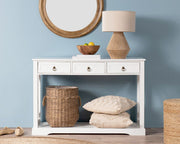
Creating a Cozy Atmosphere with Hamptons Style Interior Design
Are you yearning for a home that exudes warmth and comfort, with an elegant and timeless style? Look no further than Hamptons style interior design. Inspired by the beautiful coastal homes in the Hamptons, a series of quint towns on the east end of Long Island in New York, this design aesthetic blends a light and airy colour palette, natural textures, and a harmonious mix of modern and traditional elements to create a space that is both inviting and sophisticated. What is Hamptons Style Interior Design? Hamptons style interior design is a specific design aesthetic that draws inspiration from the beautiful and relaxed coastal homes in the Hamptons. It combines elements of classic American and coastal styles to create a look that is timeless yet refreshing. The main characteristics of Hamptons style interior design include: Light and Airy Colour Palette: Hamptons style is known for its light and neutral colour schemes. Crisp whites, soft creams, muted greys, and calming blues are commonly used to create a sense of tranquillity and openness in a space. These colours serve as a canvas for the other design elements to shine. Natural Textures and Materials: Natural materials such as timber, rattan, and linen are key to achieving the Hamptons look. These materials add warmth, texture, and organic charm to the space. Incorporating elements like timber furniture, wicker baskets, and linen upholstery helps to create that relaxed coastal feel. Combination of Classic and Contemporary: Hamptons style seamlessly blends classic and contemporary design elements. It pairs the timeless elegance of traditional styles with the clean lines and simplicity of modern design. This blend creates a look that is both sophisticated and inviting. Coastal Accents: Inspired by its coastal origins, Hamptons style often incorporates coastal-inspired accents and patterns. Think stripes, shells, coral motifs, and nautical references. These accents add a touch of the seaside and enhance the overall ambiance of the space. How to Bring the Hamptons Style into Your Home Bringing the Hamptons style into your home is easier than you might think. Starting with a few small changes, you can gradually transform your space into a cozy coastal retreat. Here are some tips to get you started: Invest in Key Furniture Pieces: Consider investing in new pieces that embody the key elements of Hamptons style. Look for furniture with VJ or statement cross side panelling, as they add a touch of classic elegance. Opt for comfortable sofas and armchairs with soft linen upholstery for that inviting feel. These furniture choices will set the foundation for your Hamptons-inspired space. Introduce Coastal Patterns: Incorporate cushions, throws, and rugs with coastal patterns such as stripes or soft watercolour designs. These patterns evoke the essence of the beach and bring a sense of serenity into your home. Don't be afraid to mix and match patterns to create depth and visual interest. Embrace Home DIY: As you start to bring the Hamptons style into your home, consider DIY projects that capture the essence of the coastline. Upcycle old furniture with a fresh coat of white paint, distress the edges for a weathered look, and swap out hardware for nautical-inspired pulls or handles. You can also create your own artwork using seashells and driftwood. These DIY touches will extend the personal and intimate feel of your Hamptons-inspired space. Mixing Hamptons Interior Design with a Modern Twist While Hamptons style is known for its classic and timeless charm, you can infuse a modern twist to create a more contemporary look. Here's how to achieve this perfect blend: Sleek and Clean Lines: Incorporate furniture and accessories with sleek and clean lines. Focus on simplicity and avoid excessive ornamentation. Look for modern pieces with simple profiles and interesting silhouettes that enhance the overall look and feel of the room. Metallic Accents: Add a touch of modern sophistication by incorporating metallic accents. Consider adding brushed brass or matte black fixtures and hardware to your kitchen or bathroom. These metallic features provide a contemporary contrast against the more traditional elements of Hamptons style. Bold and Vibrant Colours: While Hamptons style typically leans towards light and neutral colours, you can introduce pops of bold and vibrant hues to add a modern touch. Incorporate colourful accessories like artwork, pillows, or rugs to infuse energy and create visual interest within the space. Home Decor for Hamptons Interior Design To achieve the Hamptons, look, careful attention should be paid to the choice of materials, patterns, and textures. Here are some commonly used elements in Hamptons style home decor: Light-Coloured Timber: Opt for light-coloured timber furniture with a weathered or distressed finish. This not only adds a rustic touch but also contributes to the light and airy feel of the space. Stripes and Coastal Patterns: Embrace coastal patterns like stripes, sailboat prints, or ocean-inspired motifs on cushions, rugs, and curtains. These patterns evoke a sense of seaside charm and add visual interest to your space. Natural Textiles: Incorporate natural textiles like linen, cotton, rattan, jute and sisal. These materials add texture and embrace the organic feel of the Hamptons style. Use them for upholstery, curtains, bedding, or even as a natural fibre rug. Soft Colour Palette: Stick to a soft and neutral colour palette to achieve the light and airy feel of Hamptons style. Crisp whites, soft creams, gentle blues, and muted greys create a calming ambiance that is characteristic of this design aesthetic. Tips and Tricks for Perfecting the Hamptons Look To perfect the Hamptons look in your home, consider the following tips and tricks: Keep it Light and Airy: Aim for an open and spacious feel by keeping clutter to a minimum. Opt for furniture with raised legs to enhance the sense of space and allow natural light to flow. Incorporate Natural Elements: Add natural elements like fresh flowers, potted plants, and seashells to bring the beauty of the outdoors inside. These elements will help create a connection to nature, enhancing the coastal ambiance. Emphasize Texture: Layer different textures through the use of rugs, cushions, throws, and curtains. Incorporate woven baskets or rattan furniture to introduce more visual interest and depth to your space. Focus on Comfort: Incorporate comfortable seating with plush cushions and soft upholstery to create an inviting and cozy environment that is synonymous with Hamptons.

The Evolution of Nursery Design Trends
Designing a nursery is an exciting and important milestone for expecting parents. It's a space where you can create a warm and nurturing environment for your little one to grow and thrive. In this blog, we will explore the evolution of nursery design trends and provide you with practical and stylish tips to help you create the perfect nursery space for your baby. Assessing and Planning Your Space When designing a nursery, it's important to start by assessing and planning your space. Choose a quiet room that is away from high traffic areas to create a peaceful environment for your baby. Consider the natural lighting in the room and think about incorporating blackout curtains or blinds to create a soothing sleep environment. In terms of layout, create distinct zones for changing, sleeping, and feeding to maximize functionality and make the nursery space efficient for your daily routine. Safety Considerations: Nursery safety is of utmost importance. Placement of the cot is crucial to ensure a safe sleeping environment. Keep the cot away from windows, curtains, and cords, and make sure it's securely built. Remember to secure electrical points and cords to prevent accidents. Investing in outlet covers and cabinet locks will provide an added layer of safety. Choosing a Theme and Colour Palette Selecting a Theme: Choosing a theme for your nursery is a wonderful way to bring a personal touch and create a cohesive look. Consider themes that reflect your personal style and create a nurturing environment. Popular nursery themes include animals, nature, and whimsical designs. Let your imagination run wild and choose a theme that resonates with you. Colour Palette: The colour palette you choose for your nursery can greatly impact the mood and atmosphere of the room. Opt for soothing colours like soft pastels or neutral tones that create a serene and calming environment. Gender-neutral colours like greens, yellows, creams and greys are also a popular choice as they provide flexibility and can easily transition as your child grows. Selecting Essential Furniture Key Furniture Pieces: When it comes to selecting furniture for your nursery, focus on functionality and longevity. The cot is the centrepiece of the room, so invest in a sturdy and safe option. Look for features like adjustable mattress heights and convertibility to a toddler bed to make it a worthwhile investment. A changing table with built-in storage is a practical choice that will help keep all your baby essentials organized. Don't forget a comfortable feeding chair or rocking chair, where you can spend hours bonding with your little one. Space-Saving Tips: For small nurseries or if you want to make the most of your space, consider multi-use furniture options. Cots with built-in storage drawers or changing tables that convert into dressers are excellent space-saving solutions. Wall-mounted shelves are also a great way to maximize storage without taking up valuable floor space. Lighting and Decor Layered Lighting: Lighting plays a significant role in creating a warm and inviting nursery atmosphere. Embrace layered lighting by incorporating ceiling or pendant lights for general illumination, task lighting for specific activities like changing, and nightlights for a soothing glow during night-time feedings or diaper changes. Use dimmer switches to adjust the light levels according to your baby's needs. Decorating Ideas: When it comes to decor, let your creativity shine. Consider using wallpapers or murals to add visual interest to the walls. Soft textures like rugs, cushions, and curtains soften the space and create a cosy ambiance. Opt for low VOC (volatile organic compounds) paint to ensure a healthy environment for your baby. Look for non-toxic, eco-friendly paint options that are safe for your little one. Storage and Organisation Smart Storage Solutions: Efficient storage solutions are essential for keeping your nursery organized and clutter-free. Open shelves are perfect for displaying books, toys, and cute decorative items. Woven baskets and clear storage bins not only add a stylish touch but also provide practical storage for diapers, clothes, and other essentials. Incorporating storage ottomans or benches with hidden compartments adds functionality while reducing clutter. Organisational Hacks: To maintain an organized nursery, consider using labelled bins or baskets for sorting and categorizing items. Implement a system for regularly decluttering and donating items that are no longer needed. This will keep your nursery neat and functional for both you and your baby. Use drawer dividers or organizers to keep smaller items like socks, bibs, and accessories easily accessible and organized. Final Touches and Personalisation Personal Touches: Adding personal touches to your nursery is what makes it truly special. Consider incorporating handmade items, like a quilt or wall art, to infuse your nursery with love and unique charm. Display family heirlooms that hold sentimental value, such as a cherished baby blanket or a toy passed down through generations. DIY projects, such as painted wooden letters spelling out your baby's name, can also add a personalized touch to the space. Budget-Friendly Tips: When it comes to designing your nursery on a budget, DIY projects are a fantastic way to add a personal touch and save money. Get your creative juices flowing and discover the joy of crafting unique items for your little one's space. Here are some DIY project possibilities that won't break the bank. Repurpose Old Furniture: Instead of buying new furniture, consider repurposing items you already have. With a fresh coat of paint and some creative modifications, you can transform an old dresser into a charming changing table or give an unused bookshelf a new life as a storage unit for adorable nursery essentials. By repurposing, you're not only saving money but also reducing waste and embracing a sustainable approach. Handmade Nursery Decor: Personalize your nursery with handmade decor items. Create a whimsical mobile using colourful paper cut-outs or craft your own wall art using stencils and paint. Design a cosy reading nook by sewing cushions or pillows with adorable patterns that match your nursery theme. The possibilities are endless, and the effort and love you put into these DIY projects will make your nursery truly unique. Designing a nursery is an exciting journey that allows you to create a cosy and nurturing space for your little one. By assessing and planning your space, choosing a theme and colour palette, selecting essential furniture, paying attention to lighting and decor, incorporating smart storage solutions, and adding personal touches, you can create a nursery that is both practical and stylish. With a little imagination and creativity, your nursery will be a haven where precious memories are made. Happy designing!
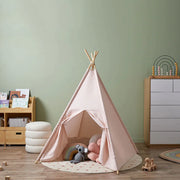
Innovative Nursery Ideas for Small Rooms
You're designing a nursery! It's an exciting time for new parents, creating a warm and welcoming space for your new bundle of joy. However, designing a nursery in a small space can present unique challenges. Fear not, for we are here to guide you through it. In this article, we will look at innovative design ideas, storage solutions, furniture options, and decor schemes suitable for small nurseries. So let your creativity flow as we explore how to make your compact nursery a cosy and functional haven for your little one.Selecting the Right Furniture Choosing the right furniture is very important in small nurseries where every square cm counts. Opt for space-saving options and look for furniture that serves multiple purposes. Start by considering a convertible cot like the fan favourite, Aspen Range. This versatile design can be adjusted as your baby grows, transforming from a bassinet to a cot, to a toddler bed. Investing in a convertible cot ensures that it can adapt and grow with your child, saving you both space and money in the long run. How to Maximize Storage in Limited Spaces? When it comes to small nurseries, effective storage solutions are critical. In addition to utilising vertical space with floating shelves and wall hooks, think outside the box and explore every nook and cranny for storage potential. One clever solution is to take advantage of the space underneath your cot by adding storage containers or drawers such as the, Mocka Under Cot Storage. These hidden gems provide extra storage while utilizing space that is often overlooked. It's the perfect place to store extra diapers, blankets, and other baby essentials, keeping them within arm's reach yet neatly tucked away. Designing a small nursery calls for innovative and practical solutions. An innovative way to utilising space is with vertical storage options. Hang baskets or wall-mounted shelves like the Sarah Scalloped Wall Shelf to utilise wall and door space. These options allow you to store diapers, wipes, pacifiers, and other small items without taking up floor space. Utilise the back of the door with hanging organizers to store blankets, clothes, or shoes. By thinking outside the box, you can find hidden storage opportunities that maximize space while keeping everything organized and within reach. Additionally, invest in modular storage solutions. These versatile systems allow you to rearrange and add onto them as your needs change. You can customize the configuration to fit your specific storage requirements, ensuring that the nursery remains organised and functional throughout your child's growth. If you're looking for a fun DIY project and have a spare unused closet, consider transforming it into a functional space for all your baby essentials by installing shelves and using hanging organisers. Or with a bit of creativity, you can turn this storage space into a functional and charming play space for your little one by removing the doors. Here a few options on how to transform a plain wardrobe into a magical little space that aligns with the nursery theme: Reading Corner: Install a small bookshelf or floating shelves, add a comfy chair, throw in some plush cushions and soft lighting for a delightful reading nook. Dress-Up Station: Hang hooks or install a low rod for tiny outfits, place a small mirror, and add storage bins for accessories to create a charming dress-up area. Toy Haven: Utilise bins, baskets, and shelving to organize toys neatly, creating a dedicated play space that's easily accessible for your little one. Nature Retreat: Infuse a touch of nature by incorporating planters or nature-themed wall decals, creating a serene and green nook within the closet. Remember, the possibilities are endless. Tailor the nook to fit the nursery's aesthetic and make it a whimsical space your little one will adore. When it comes to designing a small space, it's essential to choose furniture and storage options that make the most of every cm. Despite the common misconception that small furniture is the way to go when furnishing a compact area, it's actually more beneficial to choose larger storage options rather than several smaller pieces of furniture that are bursting at the seams. By opting for a bigger storage unit, like the Genevieve Six Drawer or Betti Bobbin Tallboy, you not only conserve valuable floor space, but you also create an elegant and tidy environment where everything has its place. This will help you avoid cluttered and cramped spaces, giving you a feeling of spaciousness and providing practical storage solutions that accommodate all your needs. TIP: To maximize space efficiency, select a dresser that doubles as a changing table, our Hamptons Change Table is a perfect choice with an abundance for storage space. These multifunctional pieces provide storage for clothes, diapers, and other essentials, while also offering a convenient changing station on top. By combining two essential items into one, you can optimize space without sacrificing functionality. Additionally, consider incorporating a slim occasional chair or rocking chair. These compact seating options provide a cosy spot for feeding, cuddling, and bonding with your baby, without overwhelming the room's footprint. Creative Decor and Colour Schemes Transforming a small space into a visually appealing nursery can be achieved through creative decor and colour schemes. Consider using light and airy colours, such as soft pastels, neutral tones, and shades of white. These hues create a sense of openness and brightness, making the room feel larger and more inviting. Introducing patterns and textures through curtains, rugs, or wallpaper can add depth and visual interest to the space. Create a lively and whimsical environment for your little one by incorporating playful prints, like polka dots, stripes, or floral motifs. Strategic placement of mirrors can also work wonders in a small nursery. Adding a mirror to one or more of the walls can create the illusion of extra space, reflecting light and making the room appear larger. Choose a stylish mirror that complements the overall design while serving as a functional and decorative element in the nursery. Thoughtful lighting choices can further enhance the overall aesthetic of the space. Adding a pendant light or wall sconces to add a touch of style and sophistication. These lighting fixtures not only provide ample illumination for the nursery but also contribute to the overall ambiance and design.Stylish Organisational Solutions Organisation is key in maintaining a clutter-free nursery. Stylish organisational solutions not only keep things tidy but also add to the overall aesthetics of the room. Choose storage containers made of natural materials like woven rattan for an organic touch or sleek wooden boxes for a modern feel. These containers not only serve as practical storage solutions but also contribute to the overall visual appeal of the nursery. To keep things organised and easily accessible, it's highly recommended to label storage containers. By clearly labelling each container or drawer, you can quickly locate specific items, saving valuable time and reducing frustration during those late-night diaper changes. Planning for the Future Lastly, when designing a small nursery, it's essential to plan for the future. Babies grow quickly, and their needs evolve with time. To accommodate these changes, choose furniture that can adapt and grow with your child. Look for cots that convert into toddler beds, ensuring that you won't need to purchase additional furniture as your child transitions from infancy to toddlerhood. Investing in modular furniture that can be rearranged or expanded upon as needed is also a practical choice. These versatile pieces allow you to adapt the nursery layout as your child's needs change, providing flexibility and longevity to your design.Conclusion Designing a nursery in a small space may come with its challenges, but it also presents a wonderful opportunity for creativity and innovation. By utilising effective storage solutions, selecting space-saving furniture, incorporating creative decor and colour schemes, and prioritizing organisation, you can create a welcoming and functional nursery for your little one. Remember, it's not about the size of the space, but the love and care you put into creating a warm and cosy environment for your bub. With these design tips and ideas, you can transform your small nursery into a haven that is practical, stylish, and perfectly tailored to your growing family's needs. So, get inspired and start transforming your compact nursery into a beautiful space that will nurture your little one's growth and bring joy to your heart.


